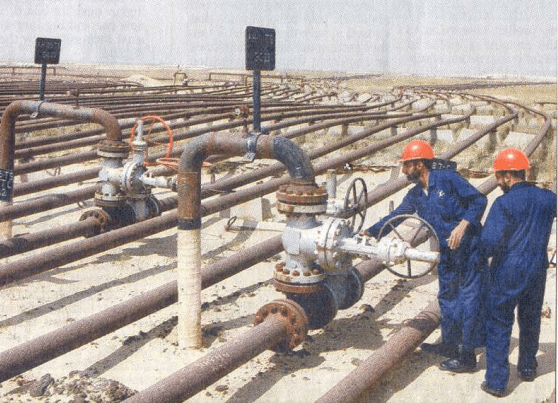INFRA-TECH CONSULTING
Infra-Tech Consulting (ITC) is committed to supporting our customers in using materials & corrosion engineering, technology, allied skills, unique methodologies, as well as best practices to provide cost-effective solutions for pipeline corrosion integrity problems faced by our customers in oil & gas industry.



SERVICES
Root Cause and Analysis Failure
Key performance indicators are used to track the efficiency of the prevailing corrosion risk management strategy, namely, the integration of corrosion, process monitoring, inspection, mitigation, environmental control, and materials management.
One methodology is the use of a single key performance indicator, namely, the corrosion rate, in tracking monitoring strategy, mitigation strategy, and pipeline integrity.
However, other key performance indicators could be used for internal corrosion monitoring activities for gathering centers, early production facilities, booster stations (operating), effluent water disposal plants, seawater treatment plant, seawater injection plant, and pipeline network carrying different products.
Corrosion and corrosivity trends are monitored using weight-loss coupons, electronic probes, bio-probes, hydrogen patch probes, galvanic probes as well.
as the measurement of iron content (total and dissolved) and manganese content. Corrosivity trend is also monitored using pH, conductivity, total dissolved solids, total hardness, dissolved oxygen, H2S concentrations, CO2 concentrations, bacterial population density and corrosion inhibitor residuals.
These activities consume significant resources that could otherwise be conserved. The cost-effective approach identifies bacterial population density as a key performance indicator.
That is, minimizing bacterial population density enables greater cost effectiveness, efficiency, reliability as well as enabling the control of the state of corrosion integrity of oilfield water handling systems.
Methodology for ranking internal corrosion-induced leakage susceptibility in oilfield pipelines
The pipeline integrity management program includes a periodic threat assessment to prioritize oilfield pipe-lines for risk from a variety of internal and external threats. Such risk ranking facilitates a timely deployment of predictive maintenance action and provides reliable safeguards against unexpected leak failures. Such failures could jeopardize mechanical integrity, operation, health, safety, and the environment, with significant financial consequences.
All transit pipelines are vital for transporting dry crude to export facilities. For threats related to the gradual deterioration of pipelines, monitoring and inspection are the two key processes by which pipeline corrosion is detected.
The online corrosion monitoring (OCM) method does detect internal corrosion significantly quicker basically because of its focus on routine monitoring not only of corrosion, but also fluid chemical characteristics, sessile bacteria, planktonic bacteria, and treatment chemical appropriateness.
On the other hand, the inline inspection (ILI) method is universally validated for a variety of pipeline integrity services, and many tools are available for these services. As for the definitive characterization of pipeline internal corrosion anomalies, the magnetic flux leakage (MFL) tool is generally used.
Ranking Pipeline Leakage Susceptibility: Crude Oil Pipeline
Microbiologically influenced corrosion is the degradation of a material under the influence of environmental factors complicated by the metabolic activities of microorganisms. Microbiological attack on process equipment used in the petroleum industry results in increased operating expenses and reduced income.
There are treatment options for various production streams to prevent corrosion and downtime of assets. Recent focus on the mitigation of micro-biologically influenced corrosion (MIC) damage relies on a judicious selection of treatment chemicals targeting specific microorganisms, identified to the genus or species level by means of recombinant DNA sequencing.
Five-year monitoring data of sessile bacteria population density, general, and pitting corrosion were used to establish a ranking of asset integrity risk for four oilfield water-handling systems. During the subsequent five years, a production shift from primary to secondary recovery method occurred. The same methodology is used to delineate the differences in the ranking of asset integrity risk occasioned by the production shift.
Black Powder in Gas Pipelines
Corrosion products such as iron sulfides, iron oxides, and iron carbonates are the major constituents of black powder observed in export gas handling facilities. Acid gases, such as hydrogen sulfide (H2S) and carbon dioxide (CO2) together with oxygen (O2), are benign in dry gas but highly corrosive when dissolved in water, either condensed or carryover water/glycol mixture.
The resulting corrosion products, which consist of fine particles of several forms of iron oxides, sulfides, and carbonates, form the basis for black powder. The focus is the investigation of black powder formation, mitigation, and prevention in export gas lines.
Ribosomal RNA Characterization of Bacteria: Linkage with Field Data Based on Culture Media
One of the major challenges that face oil companies is microbiologically influenced corrosion (MIC). In spite of biocide treatment in the facilities, the serial dilution results usually confirm a high proliferation of sessile and planktonic bacteria in all the water handling systems. Planktonic and sessile samples from different gathering centers are then analyzed for their molecular identities based on 16S rRNA characterization employing a molecular microbiological method (MMM) of quantitative polymerase chain reaction (qPCR) for enumeration of specific microorganisms.
The results usually demonstrate the presence of ten principal groups of bacteria in brackish, effluent and sea water systems. These bacterial groups can be broadly classified as aerobic and anaerobic bacteria. This is usually a linkage between the findings of 16S rRNA characterization with the field analyses of the diverse microbial population based on Serial Dilution Test Method outlined in NACE TM0194-2014.
The key issues relate to the linkage of sulfate reducing bacteria, acid producing bacteria, general aerobic, and general anaerobic bacteria with specific microorganisms. The ultimate goal is the mitigation of MIC damage in the operating facilities by targeting specific microorganisms, identified by 16S rRNA, through a judicious selection of treatment chemicals.
The Role of Bacteria Population Density in Wet and Dry Crude Asset Integrity
Consider a crude oil handling system, with various degrees of water separation/accumulation, which has been experiencing increased corrosion over a period of time. If the trend of increasing corrosion rate versus time parallels the corresponding trend of water separation/accumulation as well as bacteria population density over that same period of time, the pragmatic assumption is to ascribe the source of increased corrosion not only to water separation/accumulation but also to the increased bacteria population density.
This investigates the role of water separation/accumulation and bacteria population density on general/pitting corrosion and asset integrity in wet and dry crude handling systems. The study is intended to offer a viable corrosion control metric for microbiologically influenced corrosion (MIC) such that the population of sulfate reducing bacteria (SRB), general aerobic bacteria (GAB), and general anaerobic bacteria (GAnB) in an operating environment can be kept below a target envelop to preserve asset integrity.
Identifying Key Performance Indicators (KPIs) for Corrosion in Oilfield Water Handling Systems
Key performance indicators are used to track the efficiency of the prevailing corrosion risk management strategy, namely, the integration of corrosion, process monitoring, inspection, mitigation, environmental control, and materials management. One methodology is the use of a single key performance indicator, namely, the corrosion rate, in tracking monitoring strategy, mitigation strategy, and pipeline integrity. However, other key performance indicators could be used for internal corrosion monitoring activities for gathering centers, early production facilities, booster stations (operating), effluent water disposal plants, seawater treatment plant, seawater injection plant, and pipeline network carrying different products.
Corrosion and corrosivity trends are monitored using weight-loss coupons, electronic probes, bio-probes, hydrogen patch probes, galvanic probes as well as the measurement of iron content (total and dissolved) and manganese content. Corrosivity trend is also monitored using pH, conductivity, total dissolved solids, total hardness, dissolved oxygen, H 2 S concentrations, CO 2 concentrations, bacterial population density and corrosion inhibitor residuals. These activities consume significant resources that could otherwise be conserved. The cost- effective approach identifies bacterial population density as a key performance indicator. That is, minimizing bacterial population density enables greater cost effectiveness, efficiency, reliability as well as enabling the control of the state of corrosion integrity of oilfield water handling systems.
Corrosion/erosion management strategy in the North Slope: Use of Corrosion Rate as Key Performance Indicator ( KPI)
Corrosion management is the systematic application of policies, practices, and resources to control corrosion and provide reliable safeguards against unexpected failures and leaks that can jeopardize mechanical integrity, operation, health, safety, and the environment (HSE). This study highlights the use of a single key performance indicator in tracking monitoring strategy, mitigation strategy, and pipeline integrity for above-ground pipelines in the North Slope.
Developing a Metric for Asset Integrity Risk Ranking in Oilfield Pipeline Systems
Bacteria population density may provide a viable corrosion control metric for microbiologically influenced corrosion (MIC) in oilfield water handling systems such that the population of sulfate reducing bacteria (SRB), acid producing bacteria (APB), general aerobic bacteria (GAB), and general anaerobic bacteria (GAnB) in the operating environment can be kept below a target envelop to preserve asset integrity.
Consider, for example, a system that has been experiencing increased corrosion over a period of time. If the trend of increasing corrosion rate versus time parallels the corresponding plot of all bacteria population density over that same period of time, the general assumption is to ascribe the source of increased corrosion to increased bacteria population density. It is because of this pragmatic correlation that oil companies normally develop in-house guidelines for quantifying bacteria proliferation.
However, there is still no generally accepted method for determining such guideline unambiguously. This approach utilizes the effects of bacteria population density on general/pitting corrosion to establish an asset integrity risk ranking for the following oilfield water handling systems: brackish water, seawater, recycle water, and effluent water.
GET IN TOUCH
MEET THE CEO

The Chief Consultant of ITC is Olagoke Olabisi, PhD, NACE International Certified Corrosion Specialist, Chemical Treatment Specialist, and Lead Developer of NACE International Pipeline Corrosion Integrity Management (PCIM) Course.
Dr. Olabisi is experienced in Materials selection, Internal corrosion, Corrosion monitoring, Root cause and failure analyses (RCFA), Ranking pipeline leakage susceptibility, Black powder in gas pipelines, Pipeline corrosion integrity management, Risk assessment, Corrosion inhibitors, Vapor phase corrosion inhibitors, Volatile Corrosion Inhibitors, Chemical treatments, Microbiologically influenced corrosion (MIC), Biocides, Corrosion science, Accelerated corrosion mechanisms, Emerging corrosion technologies, and Corrosion training.
He is also experienced in designing, implementing and managing internal corrosion control systems for new projects and modifications to existing corrosion control systems.
He previously worked with Corrpro Companies, Inc., Consulting Services Department of Saudi Aramco, Internal Corrosion Monitoring Services of Kuwait Oil Company, R&D of Union Carbide Corporation, and Metals & Ceramics Division of Oak Ridge National Laboratory.